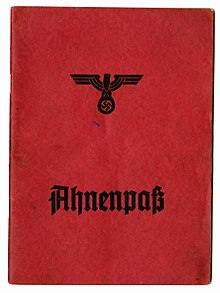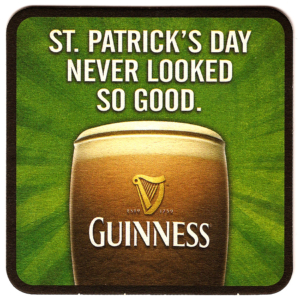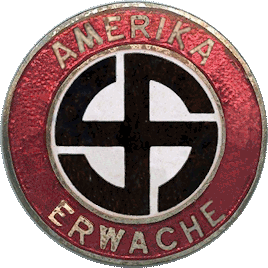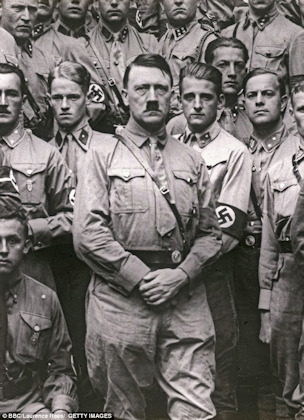We talk a lot here about “heritage” and “race”, the underlying assumption being that the reader knows their familial and racial heritage.
But it occurred to me that such an assumption may be unfounded. Particularly here in America where little emphasis is placed on bloodlines and family history, where even one’s gender is open for debate (!) it is entirely possible for a person to live their entire life and not know who their great-grandparents were, let alone where they came from originally.
So, I offer this brief “starter” to help. Whole websites and businesses are devoted to the subject, so please consider this nothing more than an attempt to “spark” the fire. A place to start, with some issues that I have run into and you might too.
But, be forewarned, once you get started, it is one hell-of-a-deep rabbit hole!

Nazi Germany, of course, placed a great deal of emphasis on a person’s family history. To join the SS, for example, required being able to prove Aryan blood back to at least 1750. Civil service jobs and the Wehrmacht generally required being able to prove non-Jewish blood. But the Germans were not the only people to emphasis bloodlines: consider the Clan system in Scotland, or the tribal system in Africa, or the caste system in India. People everywhere have always desired to know from whence they came and drawn distinctions between those closely related, and those who are not.
Thanks to DNA testing and the internet, exploring one’s past is easier than ever. Before the use of these tools, it was necessary to chase down original documents in churches, county registrars, and old family bibles.
However, even with these modern tools, it is not always a simple as it sounds and I will cover some of the difficulties you can expect to run into as we go along.

But first, let’s briefly address why research may be necessary even if you “got the skinny” from your mother or grandfather.
Simply put: anecdotal evidence is nothing more than hearsay, even if coming from a trusted source- and might be wrong. Case in point: My mother’s mother was the black-sheep of her family, and so my mother really only gleaned family history as it came up. Consequently, she was of the opinion that we had Seminole Indian blood, because she remembered Seminole Indians coming up in conversation. I grew up thinking this too.
After doing DNA testing and researching documents from the 1800’s, I was able to ascertain that we weren’t Seminole at all- we were “Swampers”- White folk who lived on either side of the Okefenokee swamp and fought against the Seminoles in all three of the Indian wars. The cousins had horses, we had bodies, and together we made a regiment and fought the Seminoles.
Another reason why research might be helpful: you could have been fed a line of BS. Case in point: My father’s mother (who was one of my most favorite people in the whole world and who I still miss every day) insisted that my father’s father was a particular individual. Period. End of discussion. (We all know where this is going). But….
Long story short: It was WWII. She was a good looking young gal. Her father was a contractor working to build a base for B-17s and B-24s. Guy number 1 was a Staff Sergeant with good pay and good prospects. Guy number 2 was the young son of another contractor from out-of-state. So… officially Guy number 1 was my father’s father. Then along comes a DNA test… 🙂
Even with the DNA, it took months of research and cross-referencing to ascertain the true story.
Lastly: Our heritage, history, and culture is clearly and irrefutably under assault with the obvious aim of erasing it forever. Your ancestors are PART of that heritage, history, and culture, and thus: you are too. How can we pass these foundational aspects of our being on to our children and grandchildren if we sit idly-by and let it slowly vanish with each passing of a generation? No longer do we sit around the fire and tell stories about our ancient kin and how they fought in this battle, or packed a bag, boarded a ship and set out for lands unknown. We were, and in our DNA still are, tribal people. And when we lived whole generations within the same 10-square-miles, we could be reasonably sure that our ties to the past and our ancestors were not going to be forgotten. This concept was very abstract to me, and likely will be for you, until you find your ancient “hometown”. And with perseverance, you will.
When I started, I had no idea where my family came from other than “Germany and Prussia” according to my Grandmother. Now, I can tell you exactly what villages my ancestors inhabited for 300-400 years. I can show you the house where one branch lived for five generations in East Prussia. I can show you the graveyard in Alsace where my ancestors are buried going back to 1740, and a few miles across the Rhein in Odenheim (now part of Karlsruhe) to 1640. On my mother’s side, I can show you the ruins of the family castle in England where my ancestor lived in 1320.
But if you don’t document your history, how will YOUR future generations know? If you don’t guide the narrative, what messages do you think the LameStream Media is going to plant in their heads? When I started the genealogical journey, it was to ascertain specific information about my family, for me. Now, I’m trying to dot the “i’s” and cross the “t’s” so that when I am gone, those that come after me will know who we are and where we come from.

A National Socialist fights for his people, and that includes honoring and preserving the memory and history of the people who came before us. The National Socialist understands, indeed, feels in his heart, that we were not made-from-whole-cloth, not individual bricks in the mud, but instead, part of a larger tapestry, a larger edifice, that includes our current racial brothers and sisters and those that preceded us, all working to create the world we want our children to inherit.

So- where to begin?
First, with a decision: to DNA or not to DNA.
There are several reputable companies that offer DNA analysis and testing. This is not a recommendation for any specific service. However, it is important to note that some focus more on the health-related part of the DNA equation (23 and Me), while others focus on the history and ethnicity (Ancestry.com, for example). I have used both, and find Ancestry more in keeping with what I wanted to know. Also, once your DNA has been tested and you have been provided the results, you can upload the analysis to other services that offer DNA comparison.
Is it necessary? No. Most of your research will involve cross-referencing scanned documents with other “trees” and research that others have done. However, approaching the task with DNA can make it easier, and more accurate: Ancestry.com, for example, will provide hints and suggestions based on your DNA, drawing from their database of other users who have submitted their DNA. This can point to common ancestors and their history, which makes it easier to tie-in to your research. If you are trying to discover an unknown ancestor, it may be all-but-necessary. Without the DNA comparison, I would never have discovered my father’s biological father, because there was NO paper trail to be found.
Second: To subscribe to a service or not.
Companies that offer DNA comparison and analysis also offer “subscriptions”. The subscriptions allow access to source documents and other services and databases that are not generally accessible for free. When first getting started, I DO recommend subscribing. HOWEVER: generally they are not the only source of the information in question. Really what they are selling is their organization and search capability. The documents usually reside elsewhere. If you can access that “elsewhere”, then you don’t need the subscription. But when first getting started, it is helpful to have the subscription as “training wheels”.
Third: One of the most useful sites does not require a subscription
Eventually you will notice that a great deal of information offered on various websites (Ancestry.com, MyHeritage/Geni.com, etc) comes from one place: Familysearch.org. You will use this site. I can all-but-guarantee it. And I recommend it. What’s interesting is 1) It’s free, and 2) It’s owned by the Mormons. I don’t know much about Mormonism, but I do know they take their ancestors seriously, and have amassed a HUGE (and I do mean GINORMOUS) collection of genealogical records in Salt Lake City.
Their website is not the most intuitive to use, but once you get the hang of it, it will be indispensable.
Fourth: Have a goal
Focus is key. You will be frustrated. You will go cross-eyed (more on why in a moment). Also, you will discover what exponential growth looks like. For example: after answering “who was my father’s father”, I wanted to physically draw a tree to show around. So, I started with me and my parents (me plus 2 names). Of course, they each had two parents (so now, my parents plus 4 names). Of course, those 4 people each had parents (so now, the previous 4 plus 2 parents each equals 8 more names)… and so on. I wanted to go back 10 generations, and realized that was researching 1,024 individuals. I’m still working on it. I haven’t figured out how to put it all on a piece of paper without using a microscope to read it.
Fifth: History matters- and handwriting
Some countries have better records than others. The English civil registers are great, and go back as far as the eye can see. German records can be spotty because of bombings during the war, and finding anything before the 30-years war (1618-1648) can be a real trick. Plus, reading Middle-High German written with a quill can be a challenge. Italy mostly has church records. Etc.
These records come into play because most websites not only offer a “tree” for you to see, and individual pages for each ancestor, but also show the source of the information.This can be vitally important when trying to find one Patrick in Ireland in the 1800’s (because EVERYONE was named Patrick, which brings me too…)
Sixth: Take your time
As noted above, you will go cross-eyed. You will find conflicting information. You will have to become a detective. This is because, according to my research, ALL men in southern Germany were named Johann before 1880. All women were named Magdalena until 1912, then all women were named Margaret. Every man from Ireland is named Patrick (or Patrick James Michael Thomas), and all the women are Mary.

I’m not kidding.
Well, maybe a little. Here’s the thing: it can be challenging to find the right Johann, or Patrick, when climbing your family tree (this is where DNA cross-referencing can be helpful). That is because the first name was often used to honor the father’s father, and the individual in question went by their MIDDLE name. For example, I have one family with 4 sons, ALL named Johann. No joke. But they are Johann Heinrich, Johann Anton, Johann Martin, and Johann Josef. They went by their middles names. Of course, all the documentation (birth/baptismal records, marriage, death- the big three) usually uses the first name. So… you back track one generation, take a look at the mother, then walk forward to the Johann’s again and find which one married the lady in question. You’ve found your Johann. Rinse, repeat. 🙂 Don’t worry, it gets more complicated. (Each of the Johann’s had a son or three also, and they wanted to honor their father, so naturally they were all named Johann too.) [Insert sound of hair-pulling here.]

If you’ve made it this far, you have what it takes to explore your genealogy. Remember, your efforts help not only yourself and your immediate family, but future generations. That is what National Socialism all about: something larger than our wee little selves.
Amerika Erwache!
Some helpful tools:
Translation (because not everything is in English): https://www.deepl.com/translator
Best free website: https://www.familysearch.org/en/
Maps (helpful to find adjacent towns and villages, and just really cool): https://www.oldmapsonline.org/
Best obscure website: https://www.wikitree.com/


Leave a Reply